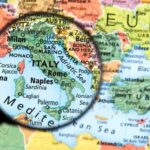The Italy government travel restrictions have been a significant topic of conversation amid the ongoing COVID-19 pandemic. As international travel continues to be impacted by the global health crisis, countries around the world have implemented various measures to control the spread of the virus, and Italy is no exception. Understanding these government-imposed restrictions is crucial for anyone planning to visit or travel within Italy.
The reasons behind Italy’s government travel restrictions are multifaceted, with public health concerns at the forefront. The country has faced significant challenges in managing the impact of COVID-19, leading to strict measures aimed at minimizing the risk of transmission. As a result, travelers must navigate through a complex web of rules and regulations to ensure compliance with Italian authorities while also prioritizing their safety and well-being.
In this article, we will delve into the current state of travel restrictions in Italy, exploring specific guidelines, entry requirements, and quarantine protocols that individuals must adhere to when entering or traveling within the country. Additionally, we will examine how these government-imposed restrictions have affected Italy’s tourism and travel industry, shedding light on the economic repercussions and decline in international visitors.
Current State of Travel Restrictions in Italy
In response to the ongoing COVID-19 pandemic, the Italian government has implemented various travel restrictions to control the spread of the virus and protect public health. Currently, individuals traveling to Italy are required to adhere to specific guidelines, including quarantine requirements and entry bans. These measures have been put in place to ensure the safety of both residents and visitors and to prevent a surge in COVID-19 cases.
As of now, Italy has categorized different countries into “List A,” “List B,” and “List C” based on their risk level for COVID-19. Travelers from countries on List A are allowed entry without any restrictions, while those from List B are required to present a negative test result taken within 48 hours before arrival or undergo testing upon arrival. Meanwhile, travelers from List C countries face stricter limitations, including a mandatory quarantine period.
It’s important for travelers planning a trip to Italy to stay informed about the latest travel restrictions and guidelines. These regulations may vary based on the traveler’s country of origin as well as the specific region they plan to visit within Italy. By remaining up-to-date with current restrictions and complying with local regulations, travelers can help ensure a smooth and safe experience during their visit to Italy.
Impact on Tourism and Travel Industry
The impact of Italy’s government travel restrictions on the tourism and travel industry has been significant. With international visitors unable to enter the country and domestic travelers facing various limitations, businesses reliant on tourism have experienced a sharp decline in revenue.
The Italian tourism industry is a crucial part of the country’s economy, contributing to job creation and regional development. The absence of travelers has not only affected popular tourist destinations but also smaller communities that rely on tourism for economic stability.
According to Italy’s National Institute of Statistics (ISTAT), there was a 58% decrease in the number of foreign tourists who visited Italy in 2020 compared to 2019, leading to a loss of an estimated 47 billion euros in tourist spending. Additionally, many businesses such as hotels, restaurants, and tour operators have struggled due to the decrease in demand caused by the travel restrictions.
Even within Italy, regions that are heavily dependent on tourism have been feeling the effects. From art cities like Florence and Venice to coastal areas such as the Amalfi Coast and Sicily, places that are traditionally popular with tourists have seen a significant drop in visitors. This has led to challenges for local businesses and communities that rely on tourism as their primary source of income.
All these factors combined have resulted in a difficult period for the tourism and travel industry in Italy. As the government continues to enforce travel restrictions to ensure public safety amid the ongoing pandemic, finding ways to support these businesses while complying with regulations remains crucial.
| Impact | Data |
|---|---|
| Tourist Spending Loss | 47 billion euros |
| Decrease in Foreign Tourists (2020 – 2019) | 58% |
Updates on Recent Changes to Travel Restrictions
Italy has been implementing various travel restrictions in response to the ongoing COVID-19 pandemic. These measures are aimed at controlling the spread of the virus and protecting public health. As of the latest update, Italy has enforced quarantine requirements for travelers arriving from certain countries, entry bans for non-essential travel from high-risk areas, and specific guidelines for different regions within the country. These restrictions have had a significant impact on international travel to and from Italy.
According to the latest data, Italy has seen a decline in tourism and international visitors due to these government travel restrictions. The tourism and travel industry in Italy has suffered economic repercussions as a result of the decrease in visitor arrivals. Businesses reliant on tourism, such as hotels, restaurants, and tour operators, have struggled amidst reduced foot traffic and lower demand for their services.
In response to the evolving situation, updates have been made to Italy’s government travel restrictions. These changes include the introduction of new protocols aimed at enhancing safety measures for travelers and residents alike. Additionally, there have been instances where certain restrictions have been lifted or modified based on changing circumstances. It is essential for travelers to stay informed about these updates in order to effectively navigate Italy’s government travel restrictions.
| Italy Travel Restrictions Updates | Date Implemented |
|---|---|
| Quarantine requirements | January 2021 |
| Entry bans for non-essential travel | March 2020 |
| New safety protocols | May 2021 |
How Travelers Can Navigate Italy’s Government Travel Restrictions
Stay Informed and Plan Ahead
Before traveling to Italy, it is essential for visitors to stay informed about the latest government travel restrictions. This includes keeping up to date with entry requirements, quarantine protocols, and any regional guidelines that may be in place. It is also crucial to plan ahead and prepare for potential changes to these restrictions. This may involve booking flexible travel arrangements, such as refundable accommodations and travel insurance that covers cancellations due to COVID-19.
Compliance with Local Regulations
When visiting Italy, travelers must ensure that they comply with all local regulations and restrictions. This may include wearing masks in public spaces, adhering to social distancing guidelines, and following any specific rules or limitations that are in place for certain tourist attractions or activities.
It is important for visitors to respect the regulations set forth by the Italian government and local authorities in order to mitigate the spread of COVID-19 and protect the health and safety of both residents and fellow travelers.
Seek Guidance from Official Sources
To navigate Italy’s government travel restrictions effectively, travelers should seek guidance from official sources, such as the websites of the Italian Ministry of Foreign Affairs and International Cooperation (MAECI) or the U.S. Department of State’s Bureau of Consular Affairs. These sources provide up-to-date information on entry requirements, travel advisories, and other essential details for visitors to Italy.
Additionally, seeking guidance from trusted travel agencies or tour operators can help ensure that travelers are well-informed and prepared for their trip while navigating any potential challenges posed by government travel restrictions.
Alternative Travel Options in Italy During Restrictions
Italy’s government travel restrictions have undoubtedly made traditional tourism experiences more challenging for visitors. However, for those willing to explore alternative options, there are still ways to enjoy Italy’s beauty and culture while adhering to the current guidelines. Here are some alternative travel options to consider during restrictions:
- Remote or Less-Visited Destinations: Instead of popular tourist hotspots, consider exploring lesser-known regions and smaller towns in Italy. These areas often offer a more authentic and tranquil experience while reducing the risk of crowded spaces.
- Outdoor Activities: Italy is blessed with stunning natural landscapes, making it an ideal destination for outdoor enthusiasts. Consider hiking in the Dolomites, exploring secluded beaches along the Amalfi Coast, or cycling through the Tuscan countryside. Engaging in outdoor activities allows travelers to maintain social distancing while still enjoying the country’s charm.
- Virtual Experiences: For those unable to visit Italy physically, virtual experiences can provide a temporary solution. Many museums, galleries, and historical sites offer virtual tours that allow individuals to explore Italian art and history from the comfort of their own homes.
By considering these alternative travel options, visitors can still experience the allure of Italy while respecting the current government travel restrictions. Whether it’s opting for remote destinations, engaging in outdoor activities, or exploring virtually, there are plenty of ways to make the most of a trip to Italy during these challenging times.
Future of Travel in Italy
With the ongoing impact of Italy’s government travel restrictions, the future of travel in Italy remains uncertain. The country’s tourism industry has faced significant challenges as a result of the pandemic, including a sharp decline in international visitors and economic repercussions for businesses reliant on tourism. As Italy continues to navigate the complexities of managing public health and its impact on travel, it raises questions about what the future of travel in Italy may look like post-pandemic.
One potential outcome is a shift towards more sustainable and responsible tourism practices. The pandemic has prompted a renewed focus on the environmental and social impact of travel, leading to a growing interest in eco-friendly and community-oriented experiences. In response, Italy may see a rise in demand for off-the-beaten-path destinations, outdoor activities, and cultural immersion opportunities that prioritize authentic interactions with local communities.
Additionally, technology is likely to play an increasingly important role in shaping the future of travel in Italy. Virtual experiences and digital platforms have become valuable resources for travelers during the pandemic, allowing them to explore destinations from afar and engage with local culture and heritage remotely. As travel restrictions ease, these virtual experiences may continue to complement traditional tourism offerings, providing accessible alternatives for those unable to physically visit Italy.
Overall, while the future of travel in Italy may present challenges, there are also opportunities for innovation and positive change within the industry. By embracing sustainable practices, leveraging technology, and adapting to evolving traveler preferences, Italy can continue to offer memorable experiences while prioritizing the safety and well-being of both visitors and local communities alike.
Conclusion
In conclusion, navigating Italy’s government travel restrictions responsibly is essential for the well-being of both travelers and the local community. The ongoing COVID-19 pandemic has significantly impacted international travel, leading to the implementation of various restrictions in Italy to protect public health. As travelers, it is crucial to stay informed about the latest guidelines and regulations, prepare for potential changes, and comply with local protocols while visiting the country.
While Italy’s government travel restrictions have undoubtedly posed challenges for the tourism and travel industry, there is hope for the future. With advancements in vaccination efforts and continued adherence to safety measures, there may come a time when these restrictions are eased or lifted entirely. In the meantime, travelers can explore alternative options such as remote destinations, outdoor activities, and virtual experiences to still enjoy all that Italy has to offer while respecting current guidelines.
Ultimately, as we navigate these challenging times, it is important to remember that responsible travel practices not only protect public health but also support the resilience of local communities and businesses. By approaching travel in Italy with empathy, respect, and mindfulness towards government regulations, we can contribute to the recovery of the tourism industry and look forward to a future of safe and enjoyable travel experiences in this beautiful country.
Frequently Asked Questions
What is the current travel advisory for Italy?
The current travel advisory for Italy varies depending on the region. Some areas may have more severe restrictions due to COVID-19, while others may be open for travel with certain precautions in place.
It’s always best to check the latest information from reliable sources such as government travel advisories or the World Health Organization before planning a trip to Italy.
What is required for a US citizen to visit Italy?
For a US citizen to visit Italy, a valid passport is required, with an expiration date at least six months beyond the date of return. Additionally, Italy is part of the Schengen Agreement, so US citizens can enter Italy for up to 90 days within a 180-day period for tourism or business purposes without a visa.
However, travelers should check for any additional entry requirements due to COVID-19, such as testing or quarantine mandates.
Are there Covid restrictions to travel to Italy?
Yes, there are COVID restrictions in place for travel to Italy. As of now, travelers entering Italy from the United States are required to present a negative COVID-19 test result taken within three days of their arrival.
Additionally, there may be quarantine requirements upon arrival in Italy depending on vaccination status and specific circumstances. It’s important for travelers to stay updated on these restrictions and requirements prior to their trip.

I’m a passionate traveler, writer, and Italophile. My fascination with Italy’s history, art, and culture has led me on countless adventures across the Italian landscape. Through “I Live Italy,” I share my love for this extraordinary country and aims to inspire others to explore its boundless beauty.





